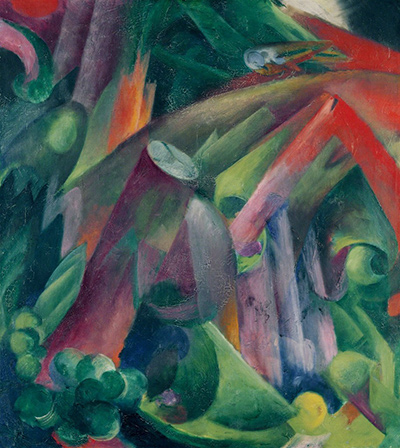Inside a Forest with a Bird is a 1912 oil on canvas piece completed in true Expressionist style
Whilst the natural and animal worlds were great obsessions and loves of Marc, this painting could not help to portray the artists' sense of isolation and of being quite alone in the world.
The way in which he has styled the forest to lean in on the viewer and the brooding colours of the forest add to the sensation of helplessness.
The one shining light of hope is the companionship of a small bird in the upper right of the painting who seems to be watching over the viewers journey through the forest.
Marc continued his career until World War 1 broke out in 1914 and Marc was recruited into the German Army. However, this did not stop Marcs' skill as an artist becoming an asset to the German military and by 1916, Marc was commissioned to create camouflage tarpaulin to help hide artillery from enemy aircraft.
Unfortunately for the artistic community, Marc would never return to the public domain as he was struck down by shrapnel during the Battle of Verdun before orders could reach him that all renowned artists were being taken out of service for their own safety.
Franz Marc was the son of landscape painter Wilhelm Marc and thus received his education at the Munich Academy of Fine Arts. At the Academy, Marcs' artistic skill developed through the naturalist techniques shown by his mentors Gabriel von Hackl and Wilhelm von Diez.
On completion of his studies, Marc travelled to France where he integrated himself into the local artistic circles and found inspiration in the works of Vincent van Gogh and Pablo Picasso. From here, a progression of development can be seen through Marcs' collections he moved away from his academic roots and found his passion in Expressionism.




